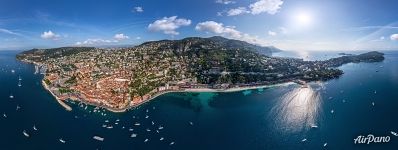Cote d'Azur. Antibes and Port Grimaud
The Mediterranean coastline of the south-east corner of France is widely known as the French Riviera (or the Côte d'Azur). The mild climate in combination with breathtaking picturesque landscapes for centuries has been attracting the amateurs of the luxurious recreation. AirPano carries on travelling through these regions.
Antibes is the second largest city in the region after Nice; it was founded by the Greek sailors back in the 6th century BC. Situated close to Nice on the opposite side of the Baie des Anges (Bay of Angels), the city was named Antipolis, literary meaning "the city, lying across". Over the course of time, the name was shortened, but the two resorts still compete with each other in many spheres.
Even being smaller than Nice, Antibes can boast having the biggest yacht port of the Côte d'Azur. It also has more than 25 kilometres of beaches and lots of monuments reflecting the unusual and bright history of this place.

One of the most famous monuments of Antibes is the Château Grimaldi built back in the 12th century atop a hill, on the place of the former Roman fortifications. At different periods it was a stronghold, a bishop's residence, a military garrison and the castle of the Grimaldi family. In 1925, the monument was bought by the local municipality and now it houses within its walls the museums of the olive tree and modern arts; the latter one was inspired by Pablo Picasso. In 1946 the artist came to the town and was looking for the place spacious enough to live and work. The local municipality offered him the Château, which eventually became his home for six months. As an appreciation, he created "Pêche de nuit à Antibes" ("Night fishing in Antibes"), as well as many other works and creations, which became the basis for the museum.
One more great landmark of Antibes is the Fort Carré built in the northern part of the town in 1565. From above (and with the help of AirPano panoramas) one can notice four arrow-head shaped bastions, together forming a star-shaped fort. In summer 1794, Napoleon Bonaparte was held in the Fort Carré for two weeks. Now the fort, surrounded by a charming park, is a major tourist destination in Antibes with different museums, one of them dedicated to the known French military and political leader.

The old Bastion Saint-André, in the same way as the Fort Carré, was a part of the defensive line of Antibes and now it houses the museum of archaeology. The most known church of the city is the Immaculate Conception built in the 12-13th centuries and having classic architectural style. On a hill aside the centre, there is the chapel of Notre-Dame de la Garoupe. The construction of this church was accomplished with the help of people's donations, it was repeatedly reconstructed, so it can hardly be called an outstanding architectural monument of the city. At the same time, it is notable for playing an important part in the life of Antibes. In order to thank for saving the city from plague and other misfortunes, residents bring different gifts, so that it looks like a museum rather than a church.
The "green" landmark of Antibes is the Jardin Botanique de la Villa Thuret, occupying over 3.5 hectares. This garden is a home to hundreds of species of plants brought here from all over the world. It was created by Gustave Thuret in the middle of the 19th century around his villa, giving the start to the whole gardening art on the Côte d'Azur.

The main attraction point of Antibes, namely the yacht port, was constructed in the 1960s on the place of the Roman harbour. The complex includes five different ports; altogether they have over 3,000 berths, some of which are suitable for mooring 100-meter yachts. One of the ports, Olivette, sits in an isolated bay and serves for mooring traditional wooden boats used by locals for fishing.
Maritime shipping is essentially important for the Côte d'Azur throughout its length. One more port shown in the AirPano panoramas is not as big as the port of Antibes, but not less notable. Port Grimaud, located in the bay of Saint-Tropez, is often called "the French Venice". It was created on marshy grounds, so first the lands were modified by piles and granite slabs. The construction was initiated in the 1960s and lasted for three decades. Now Port Grimaud serves as a good example of the exceptional city planning of the 20th century.

The population of this seaside town is around 2,000 people and, like in Venice, the transport system is based on boats and other water vehicles. Port Grimaud is a popular place among yachtsmen from all over the world: the capacity of the port is up to 2,000 yachts.

The village, located not far from here and also bearing the name Grimaud, can reveal an old aqueduct and the castle ruins dated the 11th century to the visitors. In Saint-Tropez, lying 6 kilometres from here, one can also visit a 16-17 century fortress.
Photos by Stas Sedov and Sergey Shandin
Have a look at other parts of Côte d'Azur:
• Nice
• Cannes
Read more
Photogallery Bird’s eye view of Menton
Bird’s eye view of Menton
 Saint-Jean-Cap-Ferrat
Saint-Jean-Cap-Ferrat
 Sainte-Maxime
Sainte-Maxime
 In the Port Grimaud
In the Port Grimaud
 Above the Port Grimaud
Above the Port Grimaud
 Panorama of Saint-Tropez
Panorama of Saint-Tropez
 Planet of Saint-Tropez
Planet of Saint-Tropez
 Port Grimaud from above
Port Grimaud from above
 Saint-Jean-Cap-Ferrat
Saint-Jean-Cap-Ferrat
 Saint-Tropez
Saint-Tropez
 Port of Sainte-Maxime
Port of Sainte-Maxime
 Villefranche-sur-Mer
Villefranche-sur-Mer












Virtual Travels in 360°
 Cusco, Peru
Cusco, Peru
 Antarctic Biennale
Antarctic Biennale
 New Jerusalem Monastery, Russia
New Jerusalem Monastery, Russia
 Chateaux of the Loire Valley, France. Part III
Chateaux of the Loire Valley, France. Part III
 Flower Field Meditation
Flower Field Meditation
 Animals of Galápagos archipelago, Ecuador
Animals of Galápagos archipelago, Ecuador
 Lauterbrunnen. The valley of waterfalls and mountain peaks. Switzerland
Lauterbrunnen. The valley of waterfalls and mountain peaks. Switzerland
 Zhangjiajie Glass Bridge, China
Zhangjiajie Glass Bridge, China
Show more


